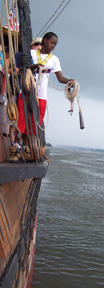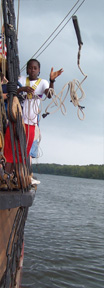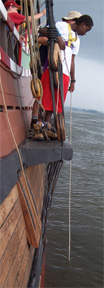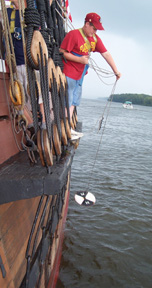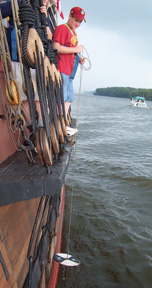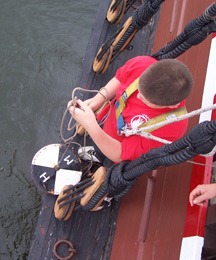 |
|
|
|
|
When the original Half Moon first ventured up the Hudson River in 1609, its crew paid close attention to the vibrant environment surrounding them, looking for ways to utilize the region's abundant natural resources. Today, on board the replica ship Half Moon, we still pay special attention to the natural world around us. The Half Moon acts as a floating ecological laboratory. Our students utilize a mixture of modern and period tools and instruments to collect their data, mixing science and history into a unified whole. This page focuses on topics of water science; the science of the river itself. Weather science follows on page two. |
Quick Links: Current Speed |
Current SpeedCurrent speed is a major factor for any waterborne craft. When we sail with the current, it speeds us along. When we move against the current, it pushes against us, slowing us down. In addition, the Hudson River is an estuary, an extension of the Atlantic Ocean that is affected by the tides all the way up to Troy. Thanks to the ebb and flood tides, the Hudson's current slows and even reverses itself several times over the course of a day. Keeping track of the Hudson's current is vital for ships looking to make good time on the river. This was all the more true in the 17th century, before ships could fall back on diesel engines to combat troublesome tides. Measuring the current is trickier than it looks. Our new crew members quickly learn that waves rippling across the water's surface don't tell us anything about the current; they're actually caused by the wind (and, with practice, can even be used to estimate wind speed). Above, Shannon demonstrates a reliable method of measuring current speed. Waves may not tell us about the current, but debris floating in the water certainly does. To measure the current, Shannon tosses a biodegradable wood chip into the water, then has an assistant at the far end of the weather deck time how long the chip takes to float past. Some quick math is all it takes to determine where the river is pushing us, and how long it'll take to get there. |
|
Soundings
When a vessel enters uncharted waters, its crew needs to be able to answer one simple, yet vital question: How deep is the water? In fact, as Juet's journal entries in our daily logs show, Hudson and his crew repeatedly faced the danger of running aground while exploring the river. Monitoring water depth is just as important for us on board the Replica Ship Half Moon. Of course, in the modern day the Hudson River has been throughly charted, and unlike Captain Hudson we have years of experience navigating this river, but a low tide and a thick silt deposit could still conspire to run our ship aground. When in doubt, we take soundings (measure the water's depth) with the same tool Hudson's crew would have used: a lead line (or sounding line). Above, Richard demonstrates its use while he charts the tidal ebb and flow over the course of a day. The flags attached to the lead line (most easily seen in the middle photo) mark depth in 6-foot increments (fathoms). With a draft of 8-1/2 feet, the Half Moon needs at least a fathom and a half of water to stay clear of the bottom. In Hudson's day, crews could even use their lead lines to take samples of the river bottom. They could fill a small hollow on the bottom of the line's lead weight with tallow, then see what stuck to their goo when they retrieved the line. Silt or sand made for a fine anchorage, but clean tallow warned of rocks lurking below, making anchorage impossible. |
|
Water ClarityParticles suspended in the river (such as silt, sediment, or plant material) determine the water's clarity (also called turbidity). Simply put, the higher the turbidity, the murkier the water. High turbidity can diffuse sunlight as it penetrates the water's surface, possibilty even affecting the local flora and fauna. In the photos here, you can see Keith using a Secchi disk to measure the turbidity of Athens Channel for his final project. Hudson's voyages predate the invention of the Secchi disk by more than two centuries; in the 17th century, sailors would simply keep an eye on objects floating beneath the water's surface.
|
|
Move your mouse over the image to the right to see Keith putting the Secchi disk to use. A Secchi disk works in a similar fashion as a lead line, except that instead of flinging a lead line overboard, its user simply lowers the disk into the water, as Keith is doing here. Once the Secchi disk itself fades out of view, Keith checks the markings on his line to see how far down into the water the disk sank before it disappeared. He can take a second reading when he pulls the disk back up, then compare the results.
|
|
Water TemperatureThe Hudson River's depth fluctuates wildly as one sails up its length. In many places, most notably just off West Point, the water is so deep that its ambient temperature often varies considerably between the bottom and the surface. Kathleen studied water temperature for her part of the team presentation. An invaluable tool for both Kathleen and Katie's research was our Van Dorn sampler, shown here. This hollow tube can be lowered to a desired depth in the water. A little jiggling then snaps the tube shut, trapping a water sample inside which can then be retrieved for analysis. This allowed Kathleen to measure water temperatures at the surface, at a fathom below the surface, and at two fathoms below, near the river's bottom. |
|
Dissolved Oxygen Levels |
|
Just a few decades ago, the Hudson River was so badly polluted that readings taken during the summer often showed no oxygen in the water. Without oxygen, a river's ecology literally suffocates, and indeed, the Hudson was just barely capable of supporting life. Fortunately, the Hudson has greatly recovered from those days, as its healthy dissolved oxygen levels attest. Katie focused on this aspect of river science for her final project. To measure dissolved oxygen levels over the course of a day, Katie performed a series of titration tests, as seen above. A titration test is a complex chemical procedure that uses changes in color to indicate the level of oxygen present in a given water sample. Like Kathleen, Katie gathered her samples from the river's surface, the bottom, and from halfway in between. She and Kathleen often took turns using the Van Dorn sampler, since they could both derive their data from a single sample. |
|
WildlifeAs mentioned above, the Hudson River is once again a thriving ecology, home to numerous forms of flora and fauna. For her final project, Riki focused on the river's avian wildlife, such as the cormorants perched atop this navigation beacon (above right). Whenever she observed a new species of bird, Riki would observe their numbers and behavior patterns, research them in our available field guide, and then create detailed illustrations from on her sightings. Of course, the Hudson River's fauna is not restricted to avians. Our avid fisherman, Mr. Dawson, caught a perch, which Mr. Prime then dissected (above left) as the students looked on. Our stowaway snapping turtle hatchling also proved a popular guest during his brief stay on board the Half Moon. |
|

